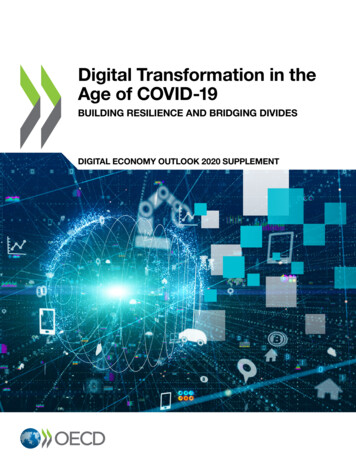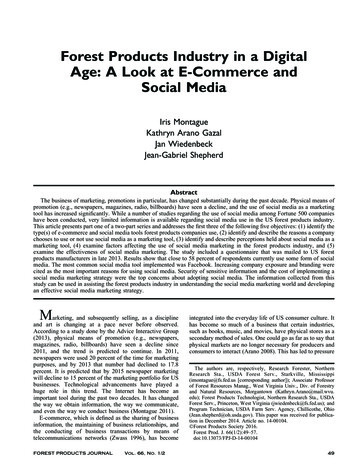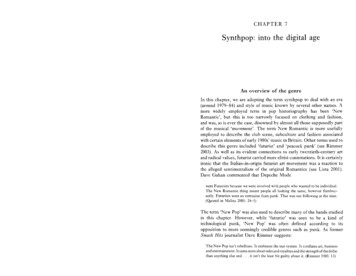
Transcription
Digital Transformation in theAge of COVID-19BUILDING RESILIENCE AND BRIDGING DIVIDESDIGITAL ECONOMY OUTLOOK 2020 SUPPLEMENT
This work is published under the responsibility of the Secretary-General of the OECD. The opinions expressed andarguments employed herein do not necessarily reflect the official views of OECD member countries.This document, as well as any data and map included herein, are without prejudice to the status of or sovereignty overany territory, to the delimitation of international frontiers and boundaries and to the name of any territory, city or area.The statistical data for Israel are supplied by and under the responsibility of the relevant Israeli authorities. The use ofsuch data by the OECD is without prejudice to the status of the Golan Heights, East Jerusalem and Israeli settlementsin the West Bank under the terms of international law.Please cite this publication as:OECD (2020), Digital Transformation in the Age of COVID-19: Building Resilience and Bridging Divides, Digital EconomyOutlook 2020 Supplement, OECD, Paris, .pdf.Photo credits: Cover iStockphoto.com/metamorworksThe use of this work, whether digital or print, is governed by the Terms and Conditions to be found at http://www.oecd.org/termsandconditions.
DIGITAL TRANSFORMATION IN THE AGE OF COVID-19When the COVID-19 pandemic broke out earlier this year, much of the world moved online, acceleratinga digital transformation that has been underway for decades. Children with at-home Internet accessbegan attending class remotely; many employees started working from home; and numerous firmsadopted digital business models to maintain operations and preserve some revenue flows. Meanwhile,mobile applications were developed to help “track and trace” the development of the pandemic; andresearchers employed artificial intelligence (AI) to learn more about the virus and accelerate the searchfor a vaccine. Internet traffic in some countries increased by up to 60% shortly after the outbreak (OECD,2020a), underscoring the digital acceleration that the pandemic sparked.While these activities demonstrate the tremendous potential of the digital transformation, thepandemic has also accentuated the gaps that remain. Although some digital divides have narrowedfast in recent years, others have not followed the same pace, leaving some behind in the COVID-induceddigital acceleration. Moreover, the increased reliance on digital solutions has added new urgency toconcerns around privacy and digital security.This presents countries with a major challenge. It is unlikely that economies and societies will returnto “pre-COVID” patterns; the crisis has vividly demonstrated the potential of digital technologies andsome changes may now be too deep to reverse. Faced with a future where jobs, education, health,government services and even social interactions may be more dependent on digital technologiesthan ever before, failing to ensure widespread and trustworthy digital access and effective use risksdeepening inequalities, and may hinder countries’ efforts to emerge stronger from the pandemic.The OECD Digital Economy Outlook 2020 (OECD, 2020b) highlights the growing importance of digital technologiesand communications infrastructures in our daily lives, and reveals that governments are increasinglyputting digital strategies at the centre of their policy agendas. As countries work to respond to and recoverfrom the COVID-19 crisis, now is the moment to ensure an inclusive digital transformation, with coordinated and comprehensive strategies that build resilience and bridge digital divides for a post-COVID era.Widespread connectivity has allowed many businesses and individuals to adaptto the crisis Fast and reliable connectivity facilitates interactions between people, organisations and machines,and enables the use of connected devices in critical contexts, including health, manufacturing andtransport. Connectivity has steadily improved over time; mobile broadband subscriptions in OECDcountries increased from 32 subscriptions per 100 inhabitants in 2009 to nearly 113 subscriptions per100 inhabitants in June 2019. At the same time, average mobile data usage quadrupled over the courseof just four years, reaching 4.6 GB in 2018, and prices for high-usage mobile broadband plans decreasedby about 60% from 2013 to 2019. Though rising at a slower pace, by June 2019 fibre accounted for 27% ofall fixed broadband subscriptions in the OECD (Figure 1), and no less than 50% in nine OECD countries.Box 1. The OECD Digital Economy Outlook 2020The OECD Digital Economy Outlook 2020 examines trends and analysesemerging opportunities and challenges in the digital economy. Ithighlights how OECD countries and partner economies are takingadvantage of information and communication technologies (ICTs) andthe Internet to meet their public policy objectives. Through comparativeevidence, it informs policy makers of regulatory practices and policyoptions to help maximise the potential of the digital economy as a driverfor innovation and inclusive growth.This third edition of the OECD Digital Economy Outlook provides aholistic overview of converging trends, policy developments anddata on both the supply and demand sides of the digital economy.It illustrates how the digital transformation is affecting economiesand societies. Finally, it provides a special focus on how the COVID-19 pandemic is amplifyingopportunities and challenges from the digital transformation.DIGITAL TRANSFORMATION IN THE AGE OF COVID-19: BUILDING RESILIENCE AND BRIDGING DIVIDES OECD 20201
DIGITAL TRANSFORMATION IN THE AGE OF COVID-19Figure 1. Fibre broadband connections, June 2019As a percentage of total fixed broadband subscriptions%90Q2 2019Q2 2017Q2 20158070605040302010KoreJa aLi path nuaS w ni aedeLa ntviaSpaIc inelaFi ndnlanN e Nor dw waZe yalPo an dLu r txe ugm albouEs rgtoSl niaovSl D enov en iaak mRe ar kpubliOE cCDCHu hil engaM ryexicTu orkeyS w Poli t z anderlaCzne c Fr dh anRe c epuA u blicN e s tratUn h e r li aite land dsStatCa esnCo adlo ambIr e i alandGe It al yrmUnai t e A u nyd stK i r iangdomIsraBe ellgiuGr meece0Notes: Fibre subscriptions data include fibre-to-the-home, fibre-to-the-premises and fibre-to-the-building and exclude fibre-to-the-cabinet andfibre-to-the-node. In Australia, a new entity using a different methodology is collecting data reported for December 2018 and onwards. Figuresreported from December 2018 comprise a series break and are incomparable with previous data for any broadband measures Australia reports tothe OECD. The OECD definition of fibre differs from fibre classifications commonly used in Australian reporting. These figures treat connectionsknown in Australia as “fibre-to-the-node” and “fibre-to-the-curb” as DSL connections, while “fibre-to-the-premises” and “fibre-to-the-basement”are treated as fibre connections. Data on technology type prior to Q2 2016 should be treated as indicative until further notice. Data for Israel areOECD estimates. Data for Switzerland and United States are preliminary.Source: OECD (2020c), Broadband Portal (database), www.oecd.org/sti/broadband/oecdbroadbandportal.htm (accessed on 14 March 2020).12 https://doi.org/10.1787/888934191331This high level of connectivity enabled many businesses and households in the OECD to transitiononline after governments implemented national lockdowns to stem the initial spread of COVID-19. InFrance, for example, it allowed businesses to operate remotely following a national lockdown orderin early 2020, and industries with the highest levels of teleworking were able to maintain businessactivity at 70% to 80% of normal levels. but COVID-19 has raised the bar and may open new dividesWith the swell of digitally enabled economic and social activity, COVID-19 has raised the stakes arounddigital access and engagement, reinforcing the fact that connectivity and use of digital technologiesare dynamic goals. Although some online activity may decline as COVID-19 treatments begin to emergeand enable greater in-person interactions, it is likely to remain high in areas for which the pandemichas acted as a catalyst, including telework, e-commerce, e-health and e-payments. This maintainspressure on establishing high-quality connectivity as well as boosting the ability of people and firmsto use increasingly sophisticated digital solutions.As governments adjust their strategies in response, they should keep in mind that increased relianceon digitalisation could risk opening new digital divides and/or exacerbating those that have provedpersistent over the years. Across OECD countries, for example, Internet users ranged from over 95%to less than 70% of the adult population in 2019 (Figure 2), and there are important demographicdifferences in Internet use. Although 58% of those aged 50-74 used the Internet daily in 2019 – upfrom only 30% in 2010 – this remains well below the average share of daily Internet users aged 16-24(the so-called “digital natives”), which was close to 95%. There are also persistent skills gaps acrossdemographic groups and countries, with people of higher skill or income levels making better use ofthe Internet and online activities, and being better able to access knowledge, job opportunities, andhealth and education services. Addressing the digital gender divide remains an important policy goal,as well: women more frequently experience job stress associated with frequent computer use at work(OECD, 2020d), and skills in high demand in digital intensive sectors are more frequently displayed bymen (OECD, 2018).2DIGITAL TRANSFORMATION IN THE AGE OF COVID-19: BUILDING RESILIENCE AND BRIDGING DIVIDES OECD 2020
DIGITAL TRANSFORMATION IN THE AGE OF COVID-19Figure 2. Internet users by age, 2019As a percentage of the population in each age groupAll%10016-24 year-olds55-74 year-olds90807060504030IcelaNo ndrwS w ayeDe deS w nm ni aLu t z e r r kxe l a nm dbourN e Ko gth reer alaUnni te J dsd apKi ang ndoFi mnlaCa ndnGe adrm aanS yAu painstraIr e l i alBe andlgiuEs mtonFr iaanAu cestCzre c O iah ECRe DpublL a ictviIs araeC lSlov Slo hil eak veUn Rep niai t e ubd licSLi tateth suanPo ialHu andC o ngast r yaRiGr c aeeceIPo t al yr tugTu alrkeBr yaM z ileC o x iclo ombia20Notes: Internet users are those having used the Internet in the last 3 months, except for Colombia and Japan (last 12 months) and the United States(any time). Data refer to 2019 except for Australia (the fiscal year ending 30 June 2017), Brazil, Canada, Colombia, Costa Rica, Japan and Mexico (2018)and Chile, Israel, Switzerland and the United States (2017). Data refer to age groups 16-74, 16-24 and 55-74 except for Israel (20-74 and 20-24), Japan(15-74 and 55-74). OECD data figures are based on a simple average of the available countries.Source: OECD (2020e), ICT Access and Usage by Households and Individuals Database, http://oe.cd/hhind (accessed in April 2020).12 https://doi.org/10.1787/888934191597There are also stark differences in digital diffusion and uptake across businesses. Before the pandemic,e-commerce accounted for 19% of firms’ turnover in the OECD (largely through business-to-businesstransactions), albeit with significant discrepancies between large firms (24%) and small firms (9%). Andalthough the use of big data has increased over time, it remains highly variant across both countriesand sectors. In 2018, more than 25% of all information and communication technology firms in theEuropean Union used big data, compared to just 10% of all firms (Figure 3).Figure 3. Business use of big data by data source and industry in the European Union, 2018As a percentage of enterprises%30Any data sourceSmart devices or sensorsGeolocation of portable devicesSocial mediaOther2016252015105teesalRer intuacufMantagncttrunsColeholesasuAdiodetr ailtaredanninpp is t ror a t it s veer a nvi icstgilodanleAlni c i e nca tl a ificct ai v nditiessstieiliUtTICnterprises0Source: OECD based on Eurostat (2019), Digital Economy and Society Statistics (database), nd-society/data/comprehensive-database (accessed in December 2019).12 https://doi.org/10.1787/888934192129DIGITAL TRANSFORMATION IN THE AGE OF COVID-19: BUILDING RESILIENCE AND BRIDGING DIVIDES OECD 20203
DIGITAL TRANSFORMATION IN THE AGE OF COVID-19If not addressed, such uneven diffusion may have important implications for firms’ productivityperformance as the pandemic continues to accelerate digitalisation, potentially widening theproductivity gap between digital adopters and digital laggards. An important factor in this divideis the skills gaps among workers that may inhibit a wider range of firms from fully leveraging thepotential of digital technologies. The business environment is also critical; the economic crisis triggeredby the pandemic is challenging the creation and survival of start-ups (OECD, 2020f) – a key source ofjob growth and innovation and often keen digital adopters – and may contribute to increased marketconcentration that could dampen digital diffusion (OECD, 2020g).Governments are increasingly putting the digital transformation at front and centreof policy agendas Many governments had strengthened their strategic approach to the digital transformation prior to theCOVID-19 pandemic. As detailed in the OECD Digital Economy Outlook 2020, 34 OECD countries had putin place a national digital strategy co-ordinated at the highest level of government as of mid-2020, withan additional five OECD countries (Chile, Colombia, Japan, Italy and Turkey) reporting co-ordination atthe prime minister/chancellery level since 2016.Governments are also devoting more attention to emerging digital technologies such as AI, blockchainand 5G infrastructure, the latter of which is critical to support enhanced mobile broadband, Internet ofThings (IoT) devices and AI appli
a digital transformation that has been underway for decades. Children with at-home Internet access began attending class remotely; many employees started working from home; and numerous firms adopted digital business models to maintain operations and preserve some revenue flows. Meanwhile, mobile applications were developed to help “track and trace” the development of the pandemic; and .











